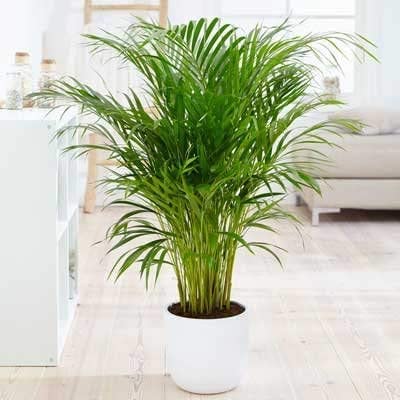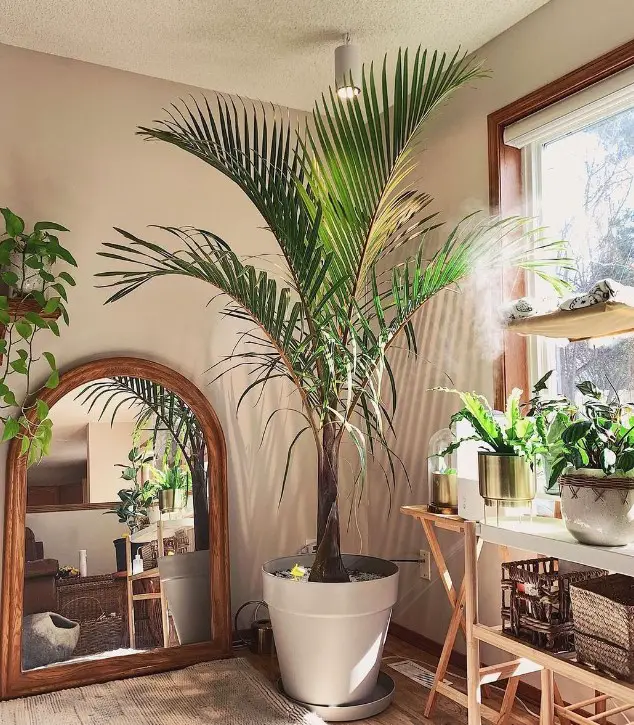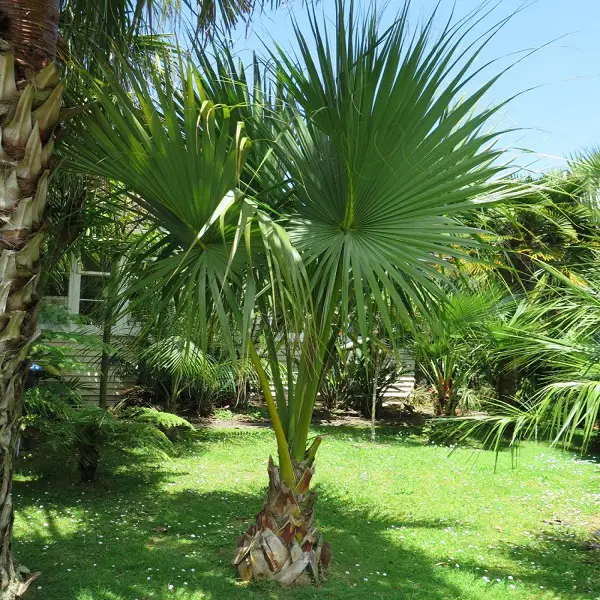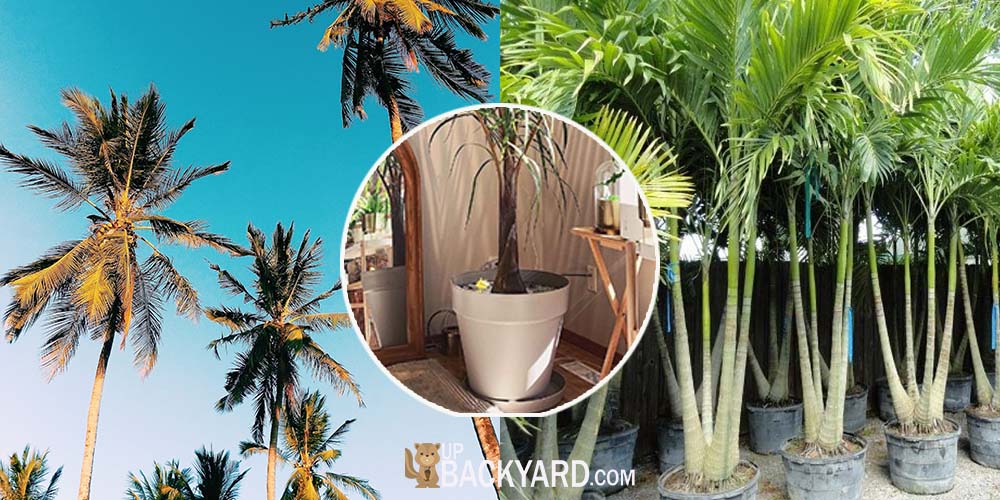Palm trees are beautiful and unique plants that add a tropical statement to landscapes and homes throughout the world. While some of these species can grow 50 feet tall or more, others stay small and can be grown in pots.
If you are looking for a plant to add to your indoor garden space or a front porch or patio, you are most likely going to choose a smaller palm tree variety.
But even these smaller variety palms can get larger than the space! How do you stop a palm tree from growing taller?
Generally, you can prune a palm tree to the desired height and shape by removing extra leaves and stems. This will help prevent your palm from getting too large and will also help slow down any future growth.
In addition to pruning your palm, there are other measures you can take to help prevent your palm plant from over growing its space. Read on to learn more about keeping palm trees small!
How To Stop My Palm Tree From Growing Taller
There are endless reasons one would want to prevent their palm trees from growing larger. Whether they are grown in pots or in the ground, large palm trees can be hard to care for.
Luckily, there are plenty of ways that you can prevent your palm tree from growing out of control.
No matter if you want your palm tree in your home or as a focal point in your yard, using these techniques will help keep your palm tree’s size under control.
Limit Pot Size

We all know that if you keep fish in a small tank, they will not grow larger. The same concept can be applied to your palm tree.
To help keep your palm tree smaller, choose a pot that matches the size of the root ball of your palm.
When you choose to grow your palm trees in a pot, you can help control how quickly and to what size they will grow.
Generally, palms will need to be repotted once every few years. When it comes time to repot them, choose a pot that is only slightly larger than the one they are currently in.
By slowly increasing the size of the pot, you are allowing your palm the space it needs to grow, but limiting the speed at which it will.
Since the plant’s roots will take up a majority of the pot, it is important to provide clean and nutrient rich soil.
You will also want to ensure that you are watering and feeding your palm tree frequently. These small but important steps will create a healthy and thriving palm tree.
Remove Excess Palm Leaves
Pruning is one of the easiest and most efficient ways of stunting the growth of your palm tree. Begin by removing any excess palm leaves and pruning the plant down to only the necessary leaves.
Be careful not to remove too much as the plant will need leaves to perform photosynthesis which is the process that plants use to get food from the sun.
Start with removing one or two leaves at a time to avoid over pruning the plant and allow a few weeks to go by in between pruning sessions.
It is best to begin by removing the leaves at the bottom of the palm. These leaves may have already turned brown and tend to be older.
You will want to leave at least two rows of stems and make sure that each stem has at least 4-5 healthy leaves on it.
Never remove more than ⅓ of the palm’s canopy and avoid removing more leaves than a palm can replace in a year. This will be different for indoor and outdoor palms.
Outdoor palms tend to grow quicker and can replace leaves at a much faster rate. Indoor palms tend to take longer to regrow their leaves, so removing too much from their canopy can cause them to die off, especially if they are a younger plant.
Keep palms indoors
As mentioned above, indoor palms are slower growing compared to palms kept outdoors. Almost any palm that can be grown outdoors will thrive under the right conditions when brought inside.
You will want to place your palm in a place that receives lots of bright indirect light.
Turning your potted palm a quarter turn every time you water it will help prevent one side from receiving too much light compared to the other sides.

Palm trees also love humidity. You can run a room humidifier for them or place them on a humidity tray to increase the humidity in the room.
While misting the leaves with a spray bottle may work temporarily, it increases the chance of a fungal infection on the palm’s leaves. It also can lead to sunburn if a wet leaf receives too much direct light.
Separate Clustering Palm Stems
Many varieties of palm plants are clustering. This means that they produce multiple stems from one root ball. While these clustering palms provide beautiful trailing and natural fences, they can be hard to keep small and trimmed.
Removing a new stem as it shoots from the root system is one way to prevent an over crowding of new palms. This is the easiest method for control and pruning.
If you are hoping to get more palm trees from your clustering palms, you can try to remove part of the root system that is attached to the new stem and repot into a new pot. This gives you endless new palm trees to either keep or give away.
Sometimes, clustering palms are used as natural fences where trailing and new growth would be encouraged.
In this case, allow your new stems to grow and mature until they have reached the height you prefer. Keeping the tops well pruned will be the best option for limiting the size of your clustering palms.
You might also like: How Do Palm Trees Survive in the Desert?
Choose A Smaller Variety of Palm
Perhaps the simplest option for those looking for a smaller palm tree, would be to simply choose a small palm tree variety.
Pygmy date palms, Dwarf Palmetto, lady palms, and European fan palms are all known for their small stature but large statements. These plants are best grown indoors in pots, providing plenty of opportunities for home decor.

If you are hoping for a small palm to go in your home, choosing varieties listed as small or dwarf will provide you with all the tropical flare you are hoping for with the size you want.
Will A Palm Tree Grow Back If You Cut Off The Top?
While we have gone over how to prevent a palm tree from growing too tall, what happens if the tree is already larger than you would like? Can you cut off the top to the height you would prefer?
Sadly, a palm tree that has had its top cut off will not grow back. Unlike other types of trees that would bud and grow new branches, a palm tree will not. In fact, palm trees are not truly trees, they are a different category altogether!
Plants need leaves to perform photosynthesis, so if you remove all the leaves from a palm plant, it will not be able to create new energy to regrow leaves.
If your palm tree is larger than you would like, there is not much you can do to shrink it. You will have to remove it completely or live with it.
How Long Do Palm Trees Live?
So if the too-large palm tree has to stay how long will it live for?
Most palm trees will live for about 70-80 years. However, like all plants, different species have different life spans. Some species of palms only live for 40 years while others can live for a century or longer!
Pay close attention to the lifespan and mature size of a plant or palm tree when you are purchasing one. You do not want to have to spend extra energy keeping a large species of palm small when you could just purchase a dwarf or small sized palm.
Final Thoughts
Palm trees are the picture perfect plant for anyone hoping to invoke a tropical or vacation vibe in their home or garden.
However, these plants can grow incredibly tall and large! Taking simple steps can help prevent a palm from overtaking or over growing its space.
Keeping the pot small, pruning all but necessary leaves, growing your plant indoors, and choosing small varieties of palms are great ways to stop your palm from growing too tall.
You should be aware that removing the tops from palms will kill the plant. These plants are not actually trees and cannot regrow new branches if the entire tops are removed.
Pay attention to the types of palms you are purchasing and be sure to choose one that has a lifespan and mature size that works for you and your garden space.
All-in-all, palm trees make a great addition to any patio or room and instantly create an atmosphere full of tropical vacation vibes. Luckily, they are fairly easy to care for and can be kept at a reasonable size!
